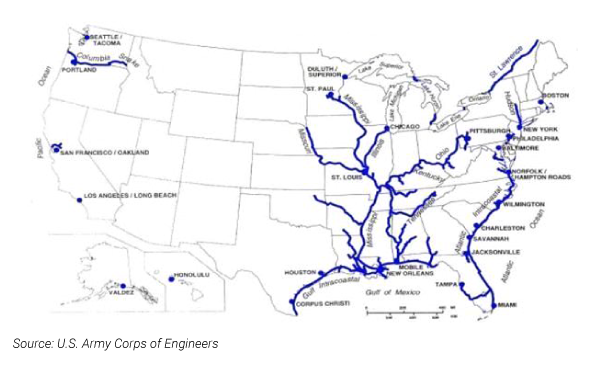“If you were born in America, you won the lottery.”—geopolitical analyst Peter Zeihan
Dear Reader,
For decades, sociologists have speculated about the reasons for America’s success. In his 1835 book Democracy in America, French author Alexis de Tocqueville attributed it to its Puritan founding. The synthesis of Puritan democratic “equality,” religion, and political liberty established “sovereignty of the people.” This principle was enshrined in the Constitution.
More recently, left-wing academics theorized that America’s success was built on slavery and exploitation. Right-wing theorists countered with the theory of American Exceptionalism. This theory espouses that freedom empowers citizens to make exceptional contributions to society.
Indeed, each theory contains at least a grain of truth. But both fail to explain America’s incredible rise.
There’s a single word that can explain it… geography.
Today, I’ll show you what I mean… and why investors shouldn’t bet against America.
Land of regenerating capital
For any nation to develop a prosperous economy, it needs the following conditions:
- Security from foreign invasion
- Affordable, efficient transportation
- Access to vital resources
- A large and growing consumer market
- A growing workforce
America leads every other country. Its geography serves as a self-sustaining source of capital.
1. Natural barriers facilitate security.
Thanks to the obstacles of nature, America has rarely needed to defend itself against invasion. Oceans protect the eastern and western borders. The Gulf of Mexico defends half of the southern border. Vast deserts and mountains buffer the other half. Mountains and lakes protect most of the northern border. Besides, with a tiny population, Canada will never represent a security threat to America.
But America spends lavishly to defend allied nations… which gives it enormous influence around the world.
2. America enjoys the greatest natural transportation network in the world.
More than 25,000 miles of navigable waterways run through the nation. This includes 13,000 miles of deep-channel waterways. In fact, America has more deep-water interior waterways than all of the rest of the world combined.
U.S. ports and navigable waterways

Interior Waterways fueled the development of industrial, inland port cities. Examples include Pittsburgh, Cleveland, Cincinnati, Detroit, Chicago, Minneapolis, Kansas City, St. Louis, and Louisville.
America also enjoys massive exterior marine highways. Ships move freely along the Atlantic, Pacific, and Gulf coasts… as well as the Great Lakes. Cheap, efficient water transportation connects American industry and consumers to the entire world.
Why are inland waterways so vital? There’s no cheaper way to transport goods than by floating them on the water. Water shipments cost half of rail… and one-tenth of trucking. These savings produce a massive, quantifiable flow of capital to the American economy.
Waterway transportation also reinforces America’s culture of freedom. As the national economy developed, businesses did not need the heavy hand of government to create efficient means of transportation.
Other countries have struggled to build adequate transportation. For example, Germany needed to build a rail network to expand industry. But a complicated geography made railroad-building difficult. It required authoritarian leadership. Understandably, Germany developed authoritarian traditions.
In Brazil, Venezuela, Columbia, and Chile, mountainous seaside terrain made the building of infrastructure nearly impossible. Wealth went to those who got the job done. Understandably, South American countries developed the tradition of crony capitalism.
But in America, easy access to low-cost waterway transportation strengthened a tradition of freedom.
Along the way, America augmented its waterway transportation with outstanding freight-rail and highway systems. No country moves goods across its nation… and throughout the world… better, faster, or cheaper than America.
America’s transportation network

3. America is endowed with amazing resources, including the largest contiguous area of arable farmland in the world.
America feeds the world. With rich farmland and advanced technology, America leads the world in agricultural production. And since its farmland lies near navigable waterways, American farmers ship food at minimal cost.
America also enjoys abundant natural resources. It holds vast stores of coal, oil and gas, iron, and minerals. Thanks to the innovation of hydraulic fracturing, the country has unlocked huge stores of oil and gas, making America the world’s largest energy producer. And cheap, abundant energy is making America the world’s favorite place for heavy industry.
4. America represents the world’s largest consumer market.
With so much opportunity at home, innovators can build successful businesses by simply catering to the American customers.
5. America’s workforce will grow for generations to come.
For every nation on earth today—for reasons that would require a separate essay—rising prosperity leads to a declining birth rate. After the birth rate drops below the replacement rate of 2.1 births per woman, the workforce eventually shrinks. (e.g., China 1.63, Japan 1.48, and Germany 1.47). When a nation’s workforce shrinks, so do the prospects for economic growth.
Not in America! Immigration supplements a relatively high birthrate (1.86 births per woman). The incentive for American immigration will continue, assuring a growing workforce well into the future.
America’s prosperity originates from its endowment of rich land with great geography. The geography will always pay dividends.
As America’s next revolution unfolds, policymakers will reserve more of America’s natural benefits for its own citizens. This is already happening, as evidenced by President Trump’s defense and trade policies. As this plays out, the U.S. economy will far outpace the rest of the world.
Make sure you align your portfolio to take advantage of this long-term trend. I recommend, for example, holding industrial manufacturing businesses.
All the best,
![[signature]](https://cdn.curzioresearch.com/wp-content/uploads/2019/09/SKoomar-sig-1.png)
Steve Koomar
Editor, Vigilante Investor
Editor’s note: Last month, Steve explained why we’re in the midst of an economic revolution that happens once in a lifetime… how its key elements are fueling a resurgence of middle-class prosperity… and one of the best ways investors can play it.















